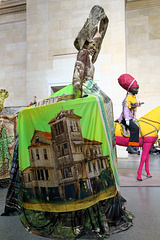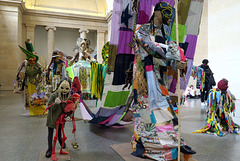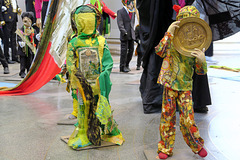
London 2022
Folder: Great Britain
My six-week stay in October - November, 2022. Separate albums for my daytrips to Cambridge, St Albans and Dungeness. Read all about it on my blog: trailerfulloftunes.blogspot.com. For best viewing, click on the first photo and then use the "Next" button or the lightbox view button on the upper right.
IMG 8522-001-Procession 10
| |
|
Hew Locke's installation in the Duveen Galleries, Tate Britain.
A procession is part and parcel of the cycle of life; people gather and move together to celebrate, worship, protest, mourn, escape or even to better themselves. This is the heart of Hew Locke’s ambitious new project, The Procession.
The Procession invites visitors to ‘reflect on the cycles of history, and the ebb and flow of cultures, people and finance and power.’ Tate Britain’s founder was art lover and sugar refining magnate Henry Tate. In the installation Locke says he ‘makes links with the historical after-effects of the sugar business, almost drawing out of the walls of the building,’ also revisiting his artistic journey so far, including for example work with statues, share certificates, cardboard, rising sea levels, Carnival and the military.
Throughout, visitors will see figures who travel through space and time. Here, they carry historical and cultural baggage, from evidence of global financial and violent colonial control embellished on their clothes and banners, alongside powerful images of some of the disappearing colonial architecture of Locke’s childhood in Guyana.
The installation takes inspiration from real events and histories but overall, the figures invite us to walk alongside them, into an enlarged vision of an imagined future.
IMG 8523-001-Procession 11
| |
|
Hew Locke's installation in the Duveen Galleries, Tate Britain.
A procession is part and parcel of the cycle of life; people gather and move together to celebrate, worship, protest, mourn, escape or even to better themselves. This is the heart of Hew Locke’s ambitious new project, The Procession.
The Procession invites visitors to ‘reflect on the cycles of history, and the ebb and flow of cultures, people and finance and power.’ Tate Britain’s founder was art lover and sugar refining magnate Henry Tate. In the installation Locke says he ‘makes links with the historical after-effects of the sugar business, almost drawing out of the walls of the building,’ also revisiting his artistic journey so far, including for example work with statues, share certificates, cardboard, rising sea levels, Carnival and the military.
Throughout, visitors will see figures who travel through space and time. Here, they carry historical and cultural baggage, from evidence of global financial and violent colonial control embellished on their clothes and banners, alongside powerful images of some of the disappearing colonial architecture of Locke’s childhood in Guyana.
The installation takes inspiration from real events and histories but overall, the figures invite us to walk alongside them, into an enlarged vision of an imagined future.
IMG 8525-001-Procession 12
| |
|
Hew Locke's installation in the Duveen Galleries, Tate Britain.
A procession is part and parcel of the cycle of life; people gather and move together to celebrate, worship, protest, mourn, escape or even to better themselves. This is the heart of Hew Locke’s ambitious new project, The Procession.
The Procession invites visitors to ‘reflect on the cycles of history, and the ebb and flow of cultures, people and finance and power.’ Tate Britain’s founder was art lover and sugar refining magnate Henry Tate. In the installation Locke says he ‘makes links with the historical after-effects of the sugar business, almost drawing out of the walls of the building,’ also revisiting his artistic journey so far, including for example work with statues, share certificates, cardboard, rising sea levels, Carnival and the military.
Throughout, visitors will see figures who travel through space and time. Here, they carry historical and cultural baggage, from evidence of global financial and violent colonial control embellished on their clothes and banners, alongside powerful images of some of the disappearing colonial architecture of Locke’s childhood in Guyana.
The installation takes inspiration from real events and histories but overall, the figures invite us to walk alongside them, into an enlarged vision of an imagined future.
IMG 8527-001-Procession 13
| |
|
Hew Locke's installation in the Duveen Galleries, Tate Britain.
A procession is part and parcel of the cycle of life; people gather and move together to celebrate, worship, protest, mourn, escape or even to better themselves. This is the heart of Hew Locke’s ambitious new project, The Procession.
The Procession invites visitors to ‘reflect on the cycles of history, and the ebb and flow of cultures, people and finance and power.’ Tate Britain’s founder was art lover and sugar refining magnate Henry Tate. In the installation Locke says he ‘makes links with the historical after-effects of the sugar business, almost drawing out of the walls of the building,’ also revisiting his artistic journey so far, including for example work with statues, share certificates, cardboard, rising sea levels, Carnival and the military.
Throughout, visitors will see figures who travel through space and time. Here, they carry historical and cultural baggage, from evidence of global financial and violent colonial control embellished on their clothes and banners, alongside powerful images of some of the disappearing colonial architecture of Locke’s childhood in Guyana.
The installation takes inspiration from real events and histories but overall, the figures invite us to walk alongside them, into an enlarged vision of an imagined future.
IMG 8528-001-Procession 14
| |
|
Hew Locke's installation in the Duveen Galleries, Tate Britain.
A procession is part and parcel of the cycle of life; people gather and move together to celebrate, worship, protest, mourn, escape or even to better themselves. This is the heart of Hew Locke’s ambitious new project, The Procession.
The Procession invites visitors to ‘reflect on the cycles of history, and the ebb and flow of cultures, people and finance and power.’ Tate Britain’s founder was art lover and sugar refining magnate Henry Tate. In the installation Locke says he ‘makes links with the historical after-effects of the sugar business, almost drawing out of the walls of the building,’ also revisiting his artistic journey so far, including for example work with statues, share certificates, cardboard, rising sea levels, Carnival and the military.
Throughout, visitors will see figures who travel through space and time. Here, they carry historical and cultural baggage, from evidence of global financial and violent colonial control embellished on their clothes and banners, alongside powerful images of some of the disappearing colonial architecture of Locke’s childhood in Guyana.
The installation takes inspiration from real events and histories but overall, the figures invite us to walk alongside them, into an enlarged vision of an imagined future.
IMG 8530-001-Procession 15
| |
|
Hew Locke's installation in the Duveen Galleries, Tate Britain.
A procession is part and parcel of the cycle of life; people gather and move together to celebrate, worship, protest, mourn, escape or even to better themselves. This is the heart of Hew Locke’s ambitious new project, The Procession.
The Procession invites visitors to ‘reflect on the cycles of history, and the ebb and flow of cultures, people and finance and power.’ Tate Britain’s founder was art lover and sugar refining magnate Henry Tate. In the installation Locke says he ‘makes links with the historical after-effects of the sugar business, almost drawing out of the walls of the building,’ also revisiting his artistic journey so far, including for example work with statues, share certificates, cardboard, rising sea levels, Carnival and the military.
Throughout, visitors will see figures who travel through space and time. Here, they carry historical and cultural baggage, from evidence of global financial and violent colonial control embellished on their clothes and banners, alongside powerful images of some of the disappearing colonial architecture of Locke’s childhood in Guyana.
The installation takes inspiration from real events and histories but overall, the figures invite us to walk alongside them, into an enlarged vision of an imagined future.
IMG 8533-001-Emmeline Pankhurst
IMG 8534-001-Millicant Garrett Fawcett
IMG 8537-001-Women of World War II
IMG 8538-001-Eyes on Whitehall
| |
|
|
|
On the side of Gwydyr House, the HQ of the secretary of state for Wales, Whitehall.
IMG 8541-001-Antelope
| |
|
Fourth plinth, Trafalgar Square.
Samson Kambalu’s bronze resin sculpture restages a photograph of Baptist preacher and pan-Africanist John Chilembwe and European missionary John Chorley, taken in 1914 in Nyasayland (now Malawi) at the opening of Chilembwe’s new Baptist church.
Chilembwe is wearing a hat, defying the colonial rule that forbade Africans from wearing hats in front of white people, and is almost twice the size of Chorley. By increasing his scale, the artist is elevating Chilembwe and his story, revealing the hidden narratives of underrepresented peoples in the history of the British Empire in Africa, and beyond.
John Chilembwe was a Baptist pastor and educator who led an uprising in 1915 against British colonial rule in Nyasaland triggered by the mistreatment of refugees from Mozambique and the conscription to fight German troops during WWI. He was killed and his church destroyed by the colonial police. Though his rebellion was ultimately unsuccessful, Malawi, which gained independence in 1964, celebrates John Chilembwe Day on January 15th and the uprising is viewed as the beginning of the Malawi independence struggle.
The artist, Samson Kambalu, was born in 1975 in Malawi, and now lives and works in Oxford where he is Associate Professor of Fine Art and a lifelong fellow at Magdalen College, Oxford University.
IMG 8545-001-Antelope 1
| |
|
|
Fourth plinth, Trafalgar Square.
Samson Kambalu’s bronze resin sculpture restages a photograph of Baptist preacher and pan-Africanist John Chilembwe and European missionary John Chorley, taken in 1914 in Nyasayland (now Malawi) at the opening of Chilembwe’s new Baptist church.
Chilembwe is wearing a hat, defying the colonial rule that forbade Africans from wearing hats in front of white people, and is almost twice the size of Chorley. By increasing his scale, the artist is elevating Chilembwe and his story, revealing the hidden narratives of underrepresented peoples in the history of the British Empire in Africa, and beyond.
John Chilembwe was a Baptist pastor and educator who led an uprising in 1915 against British colonial rule in Nyasaland triggered by the mistreatment of refugees from Mozambique and the conscription to fight German troops during WWI. He was killed and his church destroyed by the colonial police. Though his rebellion was ultimately unsuccessful, Malawi, which gained independence in 1964, celebrates John Chilembwe Day on January 15th and the uprising is viewed as the beginning of the Malawi independence struggle.
The artist, Samson Kambalu, was born in 1975 in Malawi, and now lives and works in Oxford where he is Associate Professor of Fine Art and a lifelong fellow at Magdalen College, Oxford University.
IMG 8547-001-Antelope 2
| |
|
Fourth plinth, Trafalgar Square.
Samson Kambalu’s bronze resin sculpture restages a photograph of Baptist preacher and pan-Africanist John Chilembwe and European missionary John Chorley, taken in 1914 in Nyasayland (now Malawi) at the opening of Chilembwe’s new Baptist church.
Chilembwe is wearing a hat, defying the colonial rule that forbade Africans from wearing hats in front of white people, and is almost twice the size of Chorley. By increasing his scale, the artist is elevating Chilembwe and his story, revealing the hidden narratives of underrepresented peoples in the history of the British Empire in Africa, and beyond.
John Chilembwe was a Baptist pastor and educator who led an uprising in 1915 against British colonial rule in Nyasaland triggered by the mistreatment of refugees from Mozambique and the conscription to fight German troops during WWI. He was killed and his church destroyed by the colonial police. Though his rebellion was ultimately unsuccessful, Malawi, which gained independence in 1964, celebrates John Chilembwe Day on January 15th and the uprising is viewed as the beginning of the Malawi independence struggle.
The artist, Samson Kambalu, was born in 1975 in Malawi, and now lives and works in Oxford where he is Associate Professor of Fine Art and a lifelong fellow at Magdalen College, Oxford University.
IMG 8540-001-Antelope 3
| |
|
|
Fourth plinth, Trafalgar Square.
Samson Kambalu’s bronze resin sculpture restages a photograph of Baptist preacher and pan-Africanist John Chilembwe and European missionary John Chorley, taken in 1914 in Nyasayland (now Malawi) at the opening of Chilembwe’s new Baptist church.
Chilembwe is wearing a hat, defying the colonial rule that forbade Africans from wearing hats in front of white people, and is almost twice the size of Chorley. By increasing his scale, the artist is elevating Chilembwe and his story, revealing the hidden narratives of underrepresented peoples in the history of the British Empire in Africa, and beyond.
John Chilembwe was a Baptist pastor and educator who led an uprising in 1915 against British colonial rule in Nyasaland triggered by the mistreatment of refugees from Mozambique and the conscription to fight German troops during WWI. He was killed and his church destroyed by the colonial police. Though his rebellion was ultimately unsuccessful, Malawi, which gained independence in 1964, celebrates John Chilembwe Day on January 15th and the uprising is viewed as the beginning of the Malawi independence struggle.
The artist, Samson Kambalu, was born in 1975 in Malawi, and now lives and works in Oxford where he is Associate Professor of Fine Art and a lifelong fellow at Magdalen College, Oxford University.
IMG 8551-001-Devonshire Place Mews W1
IMG 8550-001-Tyburn Manor House
IMG 8553-001-Charlotte Ossington Lucy Howard de Wa…
| |
|
One the facade of Marylebone School, Marylebone High Street. According to London Remembers, "This was erected the year after Charlotte died childless, and Lucy had inherited her great wealth so the building was probably seen as a memorial to Charlotte." The Howard de Walden Estate now extends to 92 acres in which it holds the freehold to over 800 properties.
IMG 8554-001-Spanish Place W1
Jump to top
RSS feed- Latest items - Subscribe to the latest items added to this album
- ipernity © 2007-2024
- Help & Contact
|
Club news
|
About ipernity
|
History |
ipernity Club & Prices |
Guide of good conduct
Donate | Group guidelines | Privacy policy | Terms of use | Statutes | In memoria -
Facebook
Twitter


















